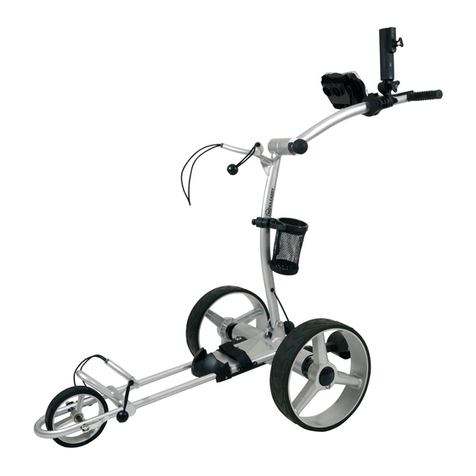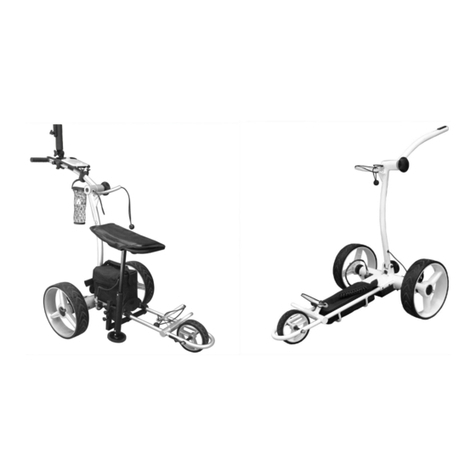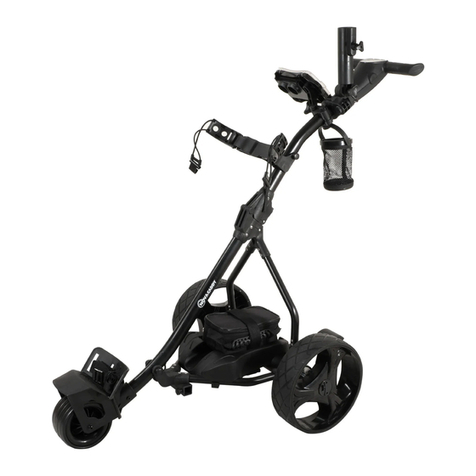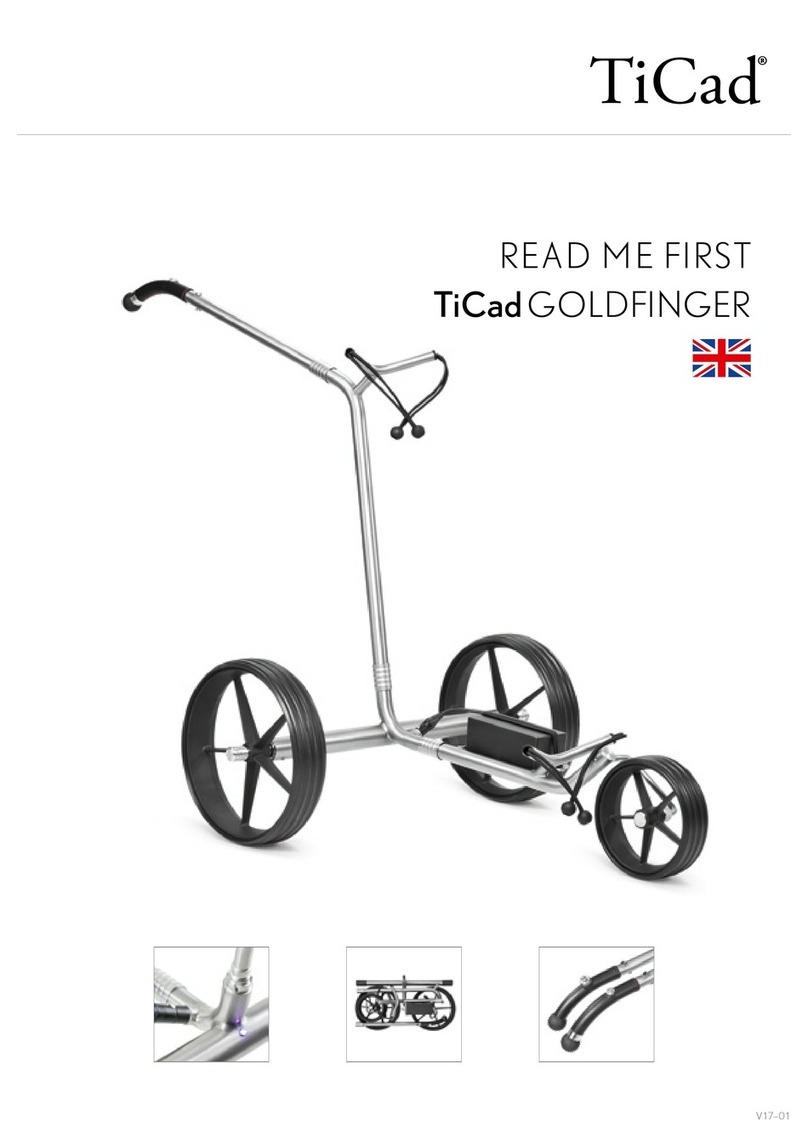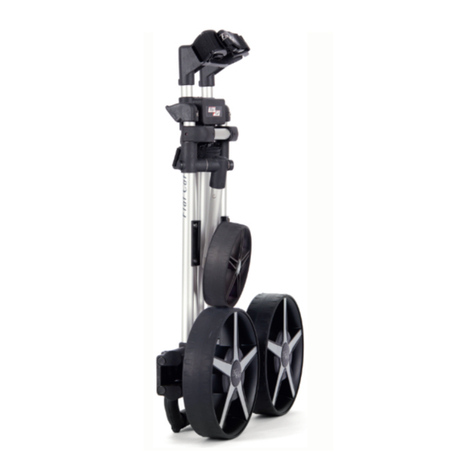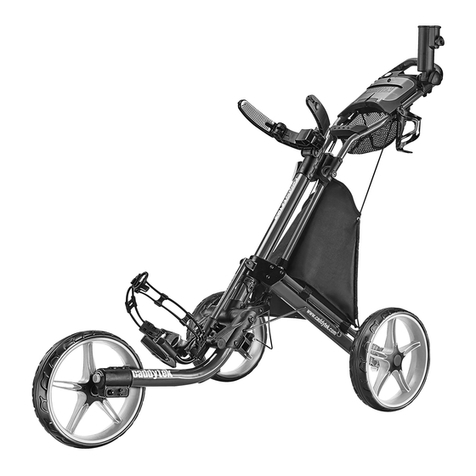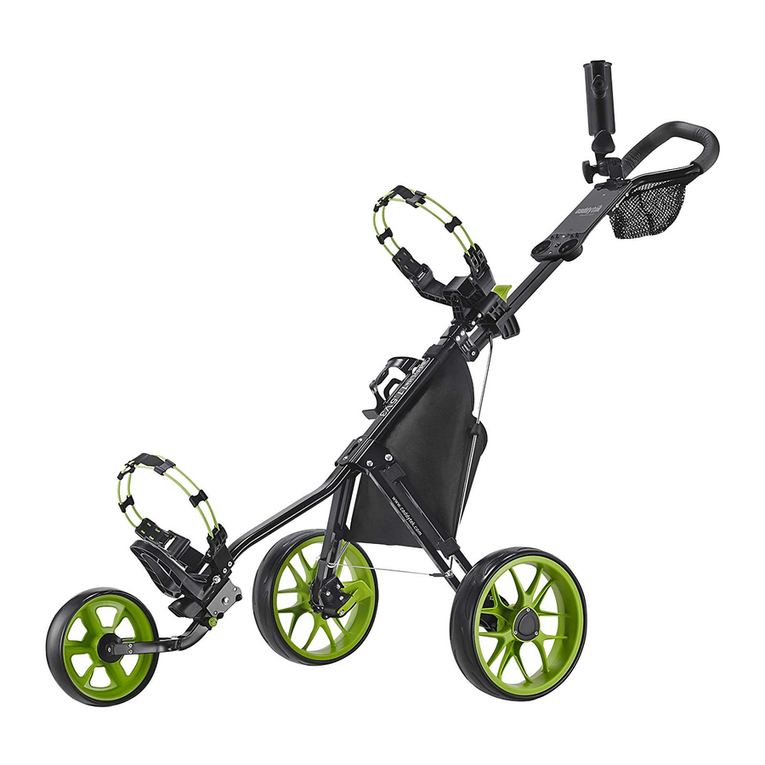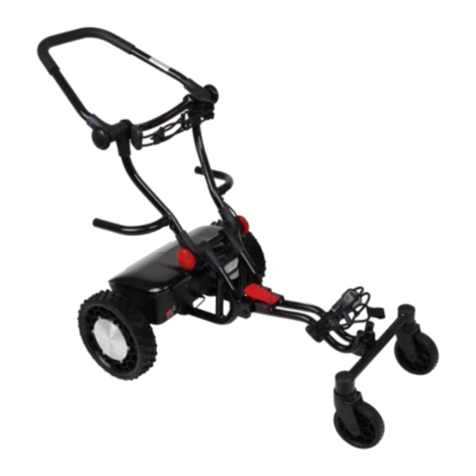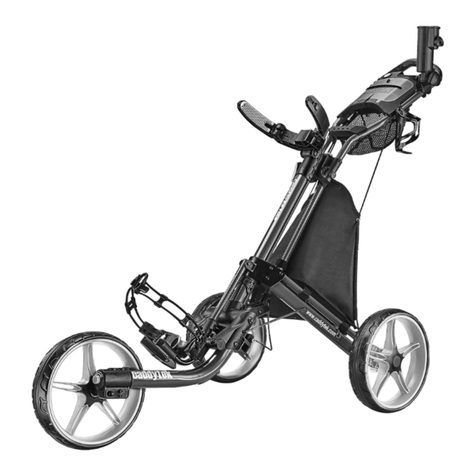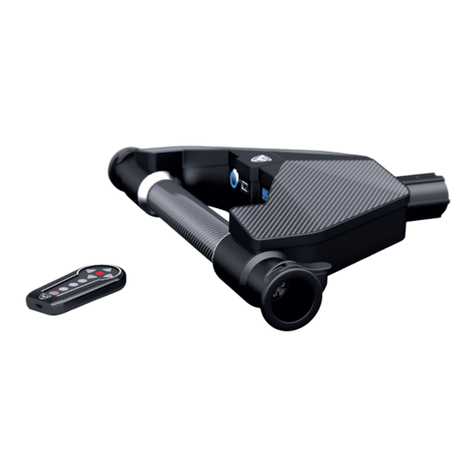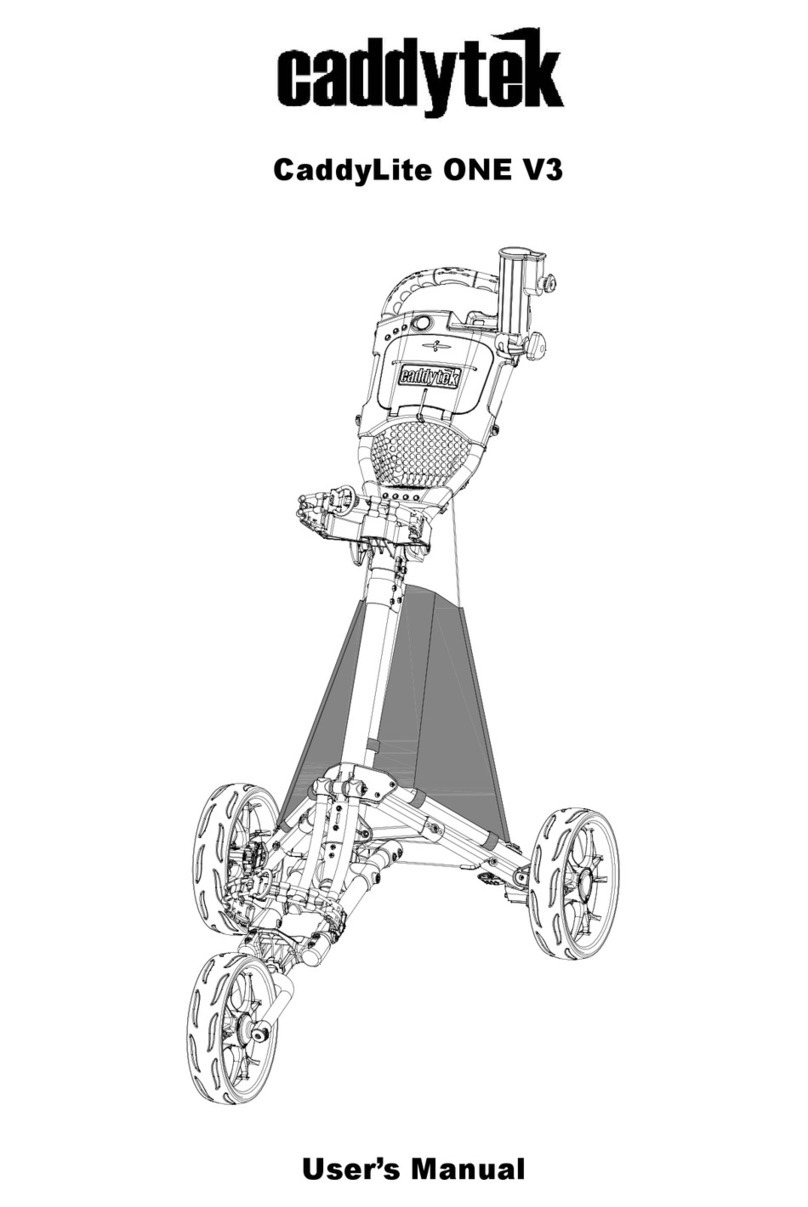Nova Caddy S1R-Digital User manual

Digital Remote Electric Golf Trolley
Model: S1R-Digital/S1R-Digital-S/S2R
User Manual
Nova Caddy Golf Products
www.novacaddy.com
Tel: +1 905-209-9937

CONTENTS
Page
1.
Packing List and Parts Glossary
2
2.
Assembly Instructions
4
3.
Operating Instructions
7
4.
Important Safety Instructions
14
5.
Electronic System
15
6.
General Maintenance
15
7.
Technical Specifications
17
8.
Trouble Shooting
18
9.
Frequently Asked Questions
18
10.
One-Year Limited Warranty
20
1

Congratulations on your purchase of the NovaCaddy S1R-Digital/ S1R-Digital-S
Remote Electric Golf Trolley. The S1R-Digital is without doubt one of the most
high performance and competitive carts in the global market for motorized golf
push carts and it represents what really counts in this market: A Great Balance
between Functionality, Performance, Practicality and Value! To ensure operate the
golf trolley properly, please read this instruction before using your S1R-Digital.
1.Packing List and Parts Glossary
Standard Parts
•1 x Caddy
•2 x Rear Wheels
•1 x Anti-flip Wheel
•1 x Battery Pack (Battery, Bag, Leads)
•1 x Battery Charger
•1 x Tool kit
•Remote handset
•User Manual
•Extras may be included as per the advert statement.
Optional Accessories
•Cup Holder
•Umbrella Holder
•Scorecard holder
•Carrying bag
•Seat Assembly
2

1.
T-Handle with LCD
7.
Bag Support Strap
2.
Manual Rheostat Speed Ctrl.
8.
Frame Lock
3.
Dual Motors/Gearbox Ass.
9.
Lower Bag Support
4.
Anti-flip Wheel
10.
Tracking Adjustment Ass.
5.
Rear Wheels
11.
Battery
6.
Upper Bag Support
12.
Front Wheel
3

2. Assembly Instructions
1.Unpack all items carefully and check everything has been included. Some
extras may be in small packages so do not throw anything away until all has
been checked.
2. Place the frame structure (one piece) on soft and clean floor and ensure that
you do not scratch the frame on a hard surface.
3. Attach the wheels to the axles by pushing the wheel locking button on the
outside of the wheel and inserting the axle extension into the wheel. Make sure
to keep the locking button on the outside of the wheel pushed in during this
process, in order to enable the axle extensions, including the two pins, to be
inserted all the way into the wheel. If not locked in, the wheel will not be
connected to the clutch and will not be propelled!!! Test the lock by trying to
pull the wheel out. To disassemble the wheels proceed in reverse order. If you
feel the wheels are not working then take them off –switch the power on and if
the axle rotates you will know you have not pushed the wheels all the way in.
4. Erect the frame by unfolding and connecting the main frame tube together at
the joint and locking the Y-shape lower support structure to the main frame
with the frame lock mechanism. Proceed in reverse for folding the caddy.
4

5. Place battery pack on battery tray and fasten Velcro strap around battery
tightly. Insert battery plug into caddy outlet.
6. Insert anti-flip wheel into frame and secure with pin.
7. Install Scorecard Holder and other accessories below handle in the foreseen
places or receptors.
5

8. Unpack remote control and install batteries as indicated in the diagram in the
receiver compartment of the unit. Now you are ready to learn and understand
the function of the manual and remote controls.
9. Installation of seat (Optional)
9.1 Attach and fasten holding bar to pre-drilled holes in frame using screw
bolt (included)
9.2 Attach stand to seat bottom using the four small screws. Attach in such manner
that the seat points parallel to the driving direction of the caddy with the opening
to the outside, once you slid it into the holding bar.
9.3 Slide seat stand into holding bar by pulling on the foot.
6

3. Operating Instructions
3.1. T-Handle Function
3.1.1. Power Vol.
H (High power): Green Color
MID (Mid power): Yellow Color .
LOW (Low power): Red Color
3.1.2. New Timer Function (Distance function)
When you press it, the trolley will run 10Meter (Yard) and stop by itself.
When you press it, the trolley will run 20Meter (Yard) and stop by itself.
When you press it, the trolley will run 30 Meter (Yard) and stop by itself.
7

3.1.3. New Cruise and Brake Function:
: Easy scrolling action lets you choose your preferred speeds to suit
your pace perfectly;
The one press stop/start (power brake) function means your cart will always
proceed at the speed you’ve selected.
Select the speed to match your pace. The cart will remember its last setting
when you stop, and travel at that speed automatically when you start again,
except when you change the speed knob position.
Power ON/OFF button controls the caddy’s power supply. Press for
2-5 seconds in order to switch the caddy ON or OFF. After you have connected
your battery, you need to press ON, and the battery LED will illuminate. Now
your caddy is ready for operation.
3.1.4. Speed controller
Scrolling of the Manual Rheostat Speed Control knob lets you choose your
preferred speed to suit your space perfectly, and the display will show the
preferred speed. The speed level is from 1 to 5.
8

3.2. Remote Control
A. Brake: The red button in the middle of the directional arrows should be
used for brake the caddy.
B. Stop/Go: Pause and Replay (same as manual control Cruise/Brake function
3.1.3)
C. Left Arrow: Initiates left turns. When the arrows are released the caddy
stops turning and continues straight with the original speed prior to turning.
D. Right Arrow: Same as left arrow function
E. Forward Arrow: Pushing the forward arrow will set the caddy in forward
motion. Pushing multiple times will increase the speed.
F. Backward Arrow: Pressing the back arrow will set the caddy in backward
motion. Increase speed by pushing multiple times.
G. LED Indicator: Remote control signal indicator
H. Antenna: Remote signal antenna
9

Important Notes:
•Change the remote control batteries once the indicator LED gets weak
•The remote control uses 2 x 1.5V AAA batteries
•To change the batteries open up the battery compartment cover and place
the batteries according to the diagram in the battery compartment
•The wire on remote is signal antenna. Broke the wire will cause remote not
function.
•The maximum range of the remote control varies between 80-120 yards,
depending on the battery charge, obstacles, atmospheric conditions, power
lines and topography of the course.
•It is strongly recommended to operate the caddy at a maximum rang
within 50 yards in order to prevent the loss of control of the caddy!
3.3. Additional Function
3.3.1. Free-wheeling Mode:
The caddy can be operated without power as a regular push cart. In order to
active the free-wheeling mode turn main power “OFF”. The caddy can be
pushed manually without resistance now.
3.3.2. Tracking Adjustment:
You can adjust the tracking of your caddy by loosing the axle and the
adjustment bar on the right side of the front wheel and shifting the axle
accordingly.
3.3.3. Remote Control Connection:
Turn caddy main power on, then press and hold any directional button on the
remote control for about 10 seconds. Your caddy should now be “connected”
to the remote control. This is used to align the caddy frequency with an
out-of-tune or replacement remote control or new control box.
10

3.4. Test Caddy
Test caddy power supply by press POWER button on T-handle. All power
volume lights (Red, Yellow, Green) should come on and caddy should be
operable by both the manual control on the T-handle and remote control.
Note: Familiarize yourself with the T-handle control and remote control
functions.
Before you start operating the caddy. NOW: Please read and follow the
operating instructions BEFORE you operate the caddy.
3.4.1. Test Environment
First, make sure that you perform your first test of the caddy in a wide and
safe area, free of obstructions or valuables, such as people, parked automobiles,
flowing traffic, water body (river, swimming pool, pond, etc.), steep hills, cliffs
or similar hazards.
4.4.3. Manual Control Operation
Turn the main power on by press POWER button on T-handle. The manual
functions of the caddy are controlled through the rheostat control knob on the
right side of the T-handle. Turn the knob forward (clockwise) will control the
forward movement of the caddy. In order to slow down the caddy, turn the
knob backward (counterclockwise). Push the GO/STOP button any time to
pause or replay the caddy. Turn the knob dead end of backward to stop the
caddy completely. Test “10M”, “20M” and “30M” timer function.
3.4.3. Remote Control Operation
Make sure you are close to the caddy at all time while testing it and
familiarizing yourself with the remote control!
Now turn on the main power of caddy, and make sure the manual speed
control knob is in “0” position (turn it to dead end of backward).
ONE touch of the Forward or Backward Arrow button on remote starts the
caddy in either direction. Further presses increase speed. In order to STOP the
caddy, press the round red STOP button in middle of the remote. To turn the
caddy in either direction, push the Left or Right Arrow button briefly. Once
you release the button, the caddy will continue in the current direction at the
same speed prior to the turning command. You will notice that the caddy
reacts promptly to any turning command, so it will take you some practice to
get just the right touch for turning maneuvers. Please be aware that the turning
characteristics will change depending on the surface (grass or asphalt), the
slope or the weight (loaded, unloaded) of your caddy.
The remote is designed to have a reach of approximately 80-120 yards, but we
11

strongly recommend to operate the caddy in closer range of 10-30 yards (do
not exceed 50 yards) to be able to react to any unforeseen events, such as other
golfers crossing your path or to avoid hidden obstructions (creeks, bunkers,
GUR, etc.) or a unexpected disconnection in remote operation. An additional
safety feature of this caddy is that it will stop moving, if it does not receive a
signal from the remote control at least every 25-30 seconds. This way, should
you ever be distracted, your caddy does not get away. By pressing the lower
middle button on the caddy can be paused or replayed.
3.5. Battery Charging and Maintenance
3.5.1. Safety Instructions for Battery Use and Charging
Please OBEY These Precautions for Battery use and Charging
3.5.1.1. Please do not charge the battery in a sealed container or in upside
down position. It is recommended to charge the battery in a well
ventilated area.
3.5.1.2. Please do not charge the battery near a heater, or where heat
accumulation may occur or in direct sunshine.
3.5.1.3. In order to prolong the service life of the battery, please avoid full
discharge and charge the battery after every use. When the trolley is not in
use for an extended period of time, it is recommended to charge the
battery once a month.
3.5.1.4. The red color battery’s pole stands for positive, and the black color
for negative. In case of battery replacement please reconnect the poles of
battery correctly. Otherwise your caddy could suffer severe damage.
3.5.1.5. Please do not disassemble the battery or throw it into a fire.
EXPLOSION!!!
3.5.1.6. Never touch the electric poles of the battery!! Safety hazard!!
3.5.2. Battery Charging
Connect the battery cable plug with the charger and then plug the charger into
an electrical outlet. During the charging cycle the indicator LED on the charger
will show a blinking green light (some models also have a red steady light
during charging). Once the charging cycle is complete, the LED indicator will
12

turn into a steady green light. It is now okay to unplug the charger and battery
for use. The charging cycle can last up to 10 hours depending on the level of
discharge.
3.5.3. Battery Maintenance
Normally the battery will hold its charge for several months, and it does not
have a “memory effect” and therefore can be recharged at any discharge level.
It is not recommended to fully discharge the battery, as this will shorten
battery life. The battery has a normal lifespan of 300 –400 charges, depending
on charging frequency, storage conditions and discharge history. Before
storing a battery for extended periods of time you must fully charge it. DO
NOT store an empty battery or else it might become unusable. Replacement
batteries are available from your authorized NovaCaddy dealer, or from
NovaCaddy directly. You can also order online at:
http://www.novacaddy.com
3.5.4. Recommendations for Battery Charging and Maintenance
3.5.4.1. Fully charge the battery for 10 hours (or the charger’s indicator
LED show stead green) before the first use.
3.5.4.2. Do not leave the battery on the charger, if it is not used for
extended periods of time.
3.5.4.3. The new battery will take approximately 2-3 rounds and charging
cycles before it reaches its full operating potential. During the first couple
of rounds, it might still be below its optimal power.
3.5.4.4. Always keep your battery fully charged before another game to
avoid a fully discharge.
3.5.4.5. Never keep your battery connected to the grid during prolonged
power outages. It might be irreversibly damaged.
3.5.4.6. Do not fully discharge the battery by “overplaying” it. It is
recommended to recharge the battery after every course play.
3.5.4.7. Keep the tops of your batteries clean and check that cables are tight.
Do not tighten or remove cables while charging or discharging. Any spark
around batteries can cause a hydrogen explosion inside, and ruin one of
the cells, and you.
The quickest way to ruin lead-acid batteries is to discharge them deeply
and leave them stand “dead” for an extended period of time. When they
discharge, there is a chemical change in the positive plates of the battery.
They change from lead oxide when charged to lead sulfate when
discharged. If they remain in the lead sulfate state for a few days, some
part of the plate does not return to lead oxide when the battery is
recharged. If the battery remains discharged longer, a greater amount of
13

the positive plate will remain lead sulfate. The parts of the plates that
become “sulfated” no longer store energy. Batteries that are deeply
discharged, and then charged partially on a regular basis can fail in less
than one year.
With proper care, lead-acid batteries will have a long service life and work
very well in almost any power system. Unfortunately, with poor treatment
lead-acid battery life will be very short.
4. Important Safety Instructions
•Be alert and act responsibly at all time while operating your caddy, just as
you would when operating a riding cart, or motor vehicle. We absolutely
do not recommend the consumption of alcohol or any other impairing
substances while operating our caddies.
•Do not operate the caddy with the remote control in narrow or dangerous
spaces, places with valuables or any people gathering areas, such as
parking lots, close to flowing traffic, bag drop-off areas, stores, driving
ranges, putting greens and practice areas, pro shops, restaurants, and other
areas where people or items could be harmed through an error or lack of
skill in operation. In such situations the caddy should be best operated with
its manual controls or free-wheeling model (power off). Also, please make
sure to always turn the power off and secure the caddy when you park
and leave the unit for any reason, either on or off course.
•With its optimized balance and straight front wheel the caddy has
extraordinarily narrow and responsive turning and maneuvering abilities.
However, it sometimes tends to react to severe uneven weight distribution
of its load or steep slope variations and follows the slope of the golf course.
Therefore, please make sure the weight in your bag is distributed evenly
(move heavy balls and items to both sides, or shift the bad on the caddy).
Also, when operating your caddy by remote control anticipate the slope of
the course in order to avoid frequent corrections in directions. In some
extreme environments, such as very uneven terrain, steep hills, narrow
and/or sloped cart paths, muddy areas, gravel paths, close to bunkers and
hazard, around bushes and trees, it is recommended to operate the caddy
via manual control in order to prevent any collisions, damage or the need
for complicated correction adjustment maneuvers.
14

5. Electronic Systems
•Remote control Range: We recommend do not to exceed 50 yards distance.
The greater the distance between you and your caddy, the greater the
chance of losing contact with it.
•Microcomputer: The remote caddy has 3 microcomputer controls. The 1st
one is in main controller box. The 2nd one is in the remote control
transmitter handset, and the 3rd is in the receiver in the handle.
•Safety Protection: When the temperature of the controller box reaches its
upper limit in case of an overload, it will automatically shut down to cool
off. Give the caddy a short time to cool down, then you can run it again.
You can still use free-wheeling model (power off) to push the cart, and
keep your game run.
•Microprocessor Controlled Electronics System: When you connect the
battery, the electronics system will automatically run through a start-up
routine. Then you can press the main power on the T-handle turn the
power ON. The battery level indicator lights will show you the battery
level. All lights ON (Green + Yellow + Red) means highest battery level.
Both of Yellow and Red on means middle battery level. Only Red on means
low battery level.
•Important: The electronics controller box contains no user serviceable parts.
Therefore, it is sealed to reduce the risk of moisture entering and impacting
the electronic system. Breaking this seal increased the risk of damaging the
electronics and decreasing the reliability of your caddy. DO NOT attempt
to open the controller case. Doing so will void the warranty!
•Battery Operation and Care: Follow battery charge and maintenance
instructions at section 3.5.
6. General Maintenance
The steps below will ensure that you get a prolonged and reliable life out of
your golf trolley.
•The Caddy has been designed so that the user can concentrate on playing
golf, whilst the caddy does the work of carrying your bag. In order to keep
your golf trolley looking at its best, we advise that you wipe any mud or
grass from the frame, wheels and chassis after every round with a damp
cloth or paper towel.
•Do NOT use any high-pressure jet washers to prevent moisture entering
the electronic systems, motors or gearboxes of the caddy.
15

•Remove the rear wheels every few weeks and remove any debris that
might cause the wheels to drag. You might also apply some lubricant, such
WD-40 to keep moving parts smooth.
•Inspect your cart at least once a year thoroughly, please contact our
customer service if there are any problem.
•Always disconnect the battery when you store the caddy, and always put
your caddy together before re-connecting the battery. If you are not
planning to play for at least a month, store the battery in a warm and dry
place (not on concrete floor) and charge once a month for 6 hours or
charger indicator turn to stead green.
All of these recommendations will help keep your trolley in top condition and
ensure that it remains your reliable partner, both on and off the course.
16

7. Technical Specification
Control
Remote control up to 120 yards
Forward, Backward, Left Turn, Right Turn, Pause in 9
speeds.
Digital T-handle control: 10, 20 and 30 meter/yard
Automatic forward cruise
Manual control
Motor
2 x 200W (400W) noiseless 12V DC motor
Drive Train
Rear Wheel Drive, Dual Stainless Steel Gears & Gear
boxes (17:1 ratio)
Dual independent transmission
Speed
Max. 8km/hr (5 MPH), 9 speed adjustable
Distance/Range per
battery charge
20km (12.5 miles)
Climbing Capability
25 degree
Max. Load
40kg (88lb)
Battery and Charger
Power: 12V, 36 Ah
Battery life time: >400 charge
Charge AC adapter: 110~240V, 50/60Hz
Weight
12.4kg (27lb) without battery
23.4 kg (51lb) with battery
Dimensions
112 x 100 x 60 cm (44 x 39 x 24 inch), Full Size
86 x 60 x 36 cm (32 x 24 x 14 inch), Folded Size
Materials
High quality aluminum alloy frame, dual stainless steel
gear box, durable polymer component
Wheels
Airless, rubberized thread
Color
Silver, brushed aluminum finish
17

8. Trouble Shooting
SYMPTOM
ACTION
Caddy does not have
power
•Check battery charge level
•Check fuse in battery case
•Check all wiring connections and plugs
•Check if wheels and clutches are in order
Motor is running, but
wheels don’t turn
•Check if wheels are secured to axle by split pin
•Check right and left wheel position
Trolley pulls to left or
right
•Check and make sure the weight in your golf bag is
distributed evenly
•Check if wheels is fitted over the clutch and latched to
axle
•Check if clutch pin is visible at both sides of the axle
•Check if the clutch turns freely in one direction only
•Do Tracking Adjustment if need ref. To 3.3.2.
Battery lacks power
•Check cable connections
•Check if fuse is 30A
•Check charger function
•Give a new full charge
•Ensure you have not completely discharged the
battery
Problems attaching
wheels
•Remove outer cap and adjust quick release catch
9. Frequently Asked Questions
Question 1: I lost my remote control handset. What shall I do?
Reply: You can purchase a new remote handset from your dealer or from
NovaCaddy.com directly. After you receive your new remote control, you can
connect the remote with your trolley. Turn caddy main power on, then press
and hold any directional button on the remote control for about 10 seconds.
Your caddy should now be “connected” to the remote control.
Question 2: When I connect the battery plug to caddy and turn the main
switch on, the battery indicator lights do not come on.
Replay:
a) Make sure battery is recharged.
b) Inspect if the fuse in the battery case is still good, and if the battery
leads are well connected to the battery
18

c) Open the back of the T-handle with a screwdriver. Make sure the
T-handle line plug is in the right position on the handle electronic
board. It will happen when the line of the caddy is not connected at
correct position in security.
Question 3: The caddy’s main power is on, and all battery indicator lights
are on, but the caddy does not run or one motor does not run.
Reply: Please check the motor connectors on the controller box and if
connector pins are in the correct position.
Question 4: The manual control function works, but the remote control does
not?
Reply:
a) Press any button on remote and check signal LED indicator light ON
for each press.
b) Please confirm that the rheostat speed know is in OFF or Stop position
(turn it backward to dead end).
c) Check the batteries status in your remote control handset.
d) The caddy frequency may out-of-tune from remote. Rebuild connection
between remote and caddy ref to section 3.3.3.
e) Check antenna wire at good condition
f) If it still does not work, open up the remote control and check the
antenna wire connection.
Question 5: The caddy does not respond well to the remote control handset.
Reply:
a) Please check the condition of the handset batteries
b) Make sure you don’t exceed the range distance limit.
Question 6: The trolley stops by itself.
Reply: Please check the battery charge. Also the controller box has a shut
down function, if the battery is too low or the controller is overheating or the
caddy does not receive a signal for a while.
Question 7: The caddy tracks to one side.
Reply:
a) Check golf bag weight balance. Make sure that the weight distribution
of your golf bag is balanced on the caddy.
b) Slope, deep or wet grass may make different friction on different wheel
to cause caddy run to one side.
c) Caddy need to do tracking adjustment, ref to section 3.3.2
19
This manual suits for next models
2
Table of contents
Other Nova Caddy Golf Trolley manuals

